Tech Tuesday – Five Minute Wheel True
Wire-spoke wheels are simple, strong and lightweight, but each component depends upon its neighbors for protection. As long as the spokes are evenly tensioned and the rim is round, the force of an impact is distributed around the circumference of the wheel. As stress and damage cause individual spokes to loosen, the job is shouldered by fewer spokes in tension. If you let all the spokes go slack, then the job of supporting the rider and his or her botched landings goes to the few spokes that happen to oppose the vector of force – which usually results in broken spokes and game over.
Without belaboring the point, a quick check of your spokes and the condition of your wheels is a good idea. If you do find a few loose spokes and a wobbly rim, use the following five-minute wheel tuneup to get all the bits spinning in a perfect circle again. Tuning a wheel is as easy as restoring the spoke tension and tightening right-side spokes to move the rim to the right, or the left-side spokes to move the rim to the left. The key is to make everything happen in order so that fixing the wobble doesn't result in uneven spoke tension. You may be surprised at how simple the task can be..
Tip: Some wheels, like DT Swiss Tricon, have powerful locking fluid applied to the threads that requires advanced truing techniques and should be left to a proper mechanic. Also, if you get lost in the process of tensioning or truing a wheel, admit defeat and stop right there. Your local bike shop is well equipped to true wheels and it is a lot easier for a mechanic to fix a slightly wobbly one than a wheel that a customer has ‘trued’ to destruction.
Warning: Never use pliers to tighten a spoke nipple unless your wheel is only one ride away from destruction anyway and you have already stripped the working edges of the nipples.
![What You ll Need Proper spoke wrench. For standard square nipples choose the type that grabs three corners. Park and DT Swiss make the best. Some spokes use tiny hex nuts and others use splined nipples. - If your wheels have bladed spokes you ll need a second slotted tool that prevents the spoke from twisting as you tension the nipple. - Mavic top and Shimano lower left wheels are shipped with both a slotted and a splined spoke wrench. - Not shown but quite handy is a felt-tip pen to mark the apex of a wobble in the rim that needs straightening.]()
Pinkbike's Five-Minute Wheel True
![checking runout with spoke wrench]()
![check spokes for tension]()
![Start at the valve hole]()
![multi]()
![work in threes]()
![plinking the spokes]()
![recheck the runout]()
Past Tech Tuesdays:
Without belaboring the point, a quick check of your spokes and the condition of your wheels is a good idea. If you do find a few loose spokes and a wobbly rim, use the following five-minute wheel tuneup to get all the bits spinning in a perfect circle again. Tuning a wheel is as easy as restoring the spoke tension and tightening right-side spokes to move the rim to the right, or the left-side spokes to move the rim to the left. The key is to make everything happen in order so that fixing the wobble doesn't result in uneven spoke tension. You may be surprised at how simple the task can be..
Tip: Some wheels, like DT Swiss Tricon, have powerful locking fluid applied to the threads that requires advanced truing techniques and should be left to a proper mechanic. Also, if you get lost in the process of tensioning or truing a wheel, admit defeat and stop right there. Your local bike shop is well equipped to true wheels and it is a lot easier for a mechanic to fix a slightly wobbly one than a wheel that a customer has ‘trued’ to destruction.
Warning: Never use pliers to tighten a spoke nipple unless your wheel is only one ride away from destruction anyway and you have already stripped the working edges of the nipples.
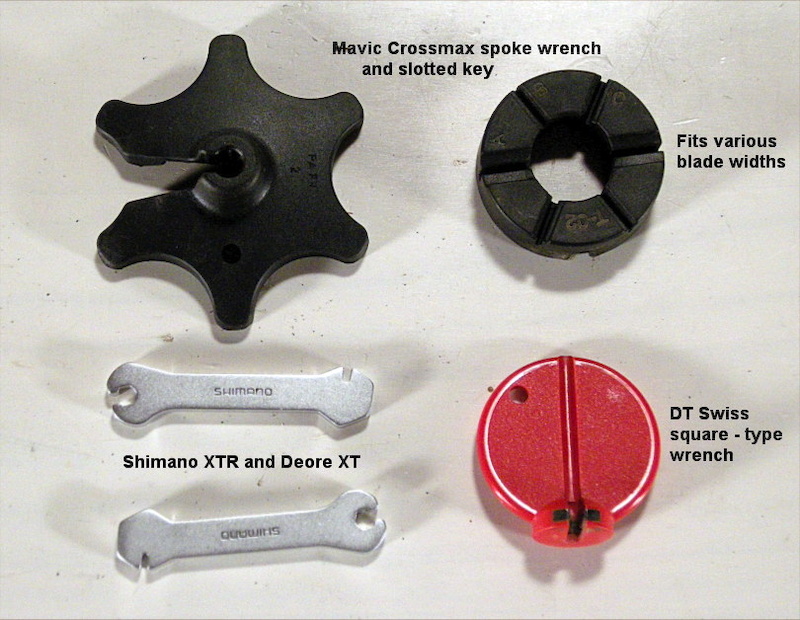
What you'll Need:
- A proper spoke wench. For square nipples, use the type that grab at least three corners (Park Tool and DT Swiss make the best).
- Some wheels use tiny hex nuts and others have special splined nipples.- If your wheels have bladed spokes, you may need a second, slotted wrench to keep the spoke from twisting. Mavic (top) and Shimano (lower left) are equipped with slotted wrenches.
- Not shown, but handy, is a felt tip pen to mark the apex of each wobble.
- A proper spoke wench. For square nipples, use the type that grab at least three corners (Park Tool and DT Swiss make the best).
- Some wheels use tiny hex nuts and others have special splined nipples.
- Not shown, but handy, is a felt tip pen to mark the apex of each wobble.

Step one: Assess the wheel. Put the bike in a stand or simply turn it upside down and give the wheel a spin. Runout (sideways wobble) over one millimeter (1/16-inch) is worth fussing with. At or below that threshold is a perfectly acceptable wheel for disc-brake bikes. Finally, watch the rim as the wheel spins for any significant flat spots. The rim must be round to remain strong. A little flat spot can be nursed for a long time, but a big one usually means game-over and a rim replacement.
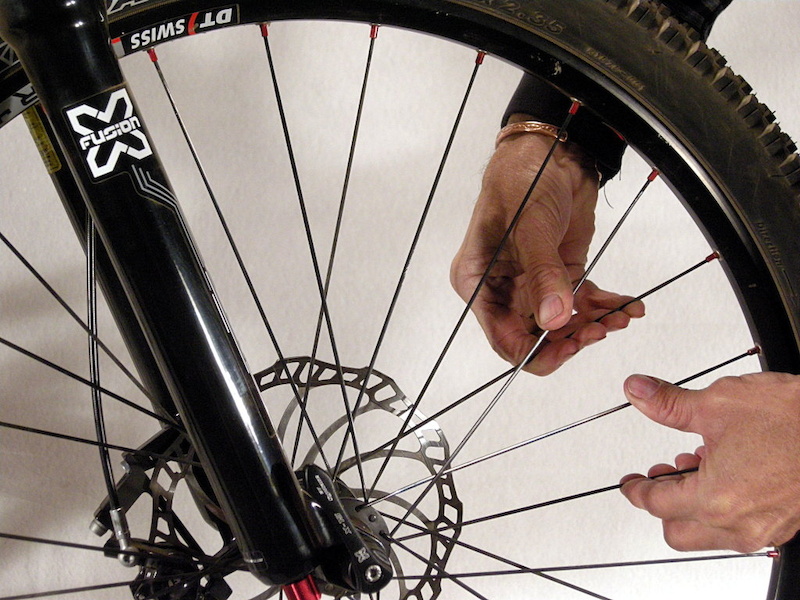
Step two: work around the wheel and squeeze each spoke. You are searching for either a loose pair or a loner that is significantly looser than the rest. It may help to squeeze the spokes of a good wheel to establish a base line.
Tip: Plink each spoke with a fingernail and listen to the tone. All the spokes on one side of the hub should ring about the same. A significantly lower note signals a low-tensioned spoke.
Tip: Plink each spoke with a fingernail and listen to the tone. All the spokes on one side of the hub should ring about the same. A significantly lower note signals a low-tensioned spoke.
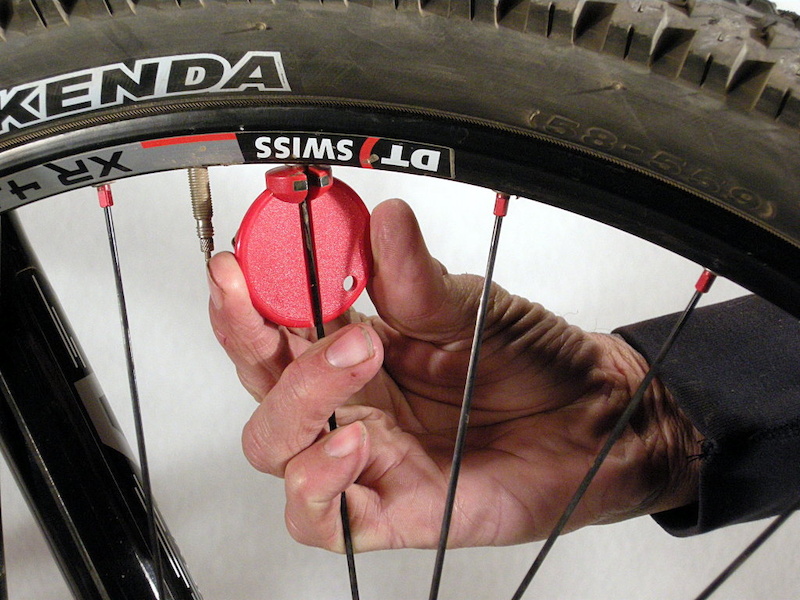
Step three: Begin at the valve stem and work around the wheel, tensioning the slack spokes. Tighten the nipples one-half turn and then reverse about a quarter of a revolution. This unwinds the spoke and ensures that you are turning the threads each time. Bring up the slack spokes about 90 percent of the properly tensioned spokes and don't worry about rim runout yet. If you have bladed spokes, grasp the bladed part close to the nipple with the slotted wrench and only tension the spokes one fourth revolution at a time.
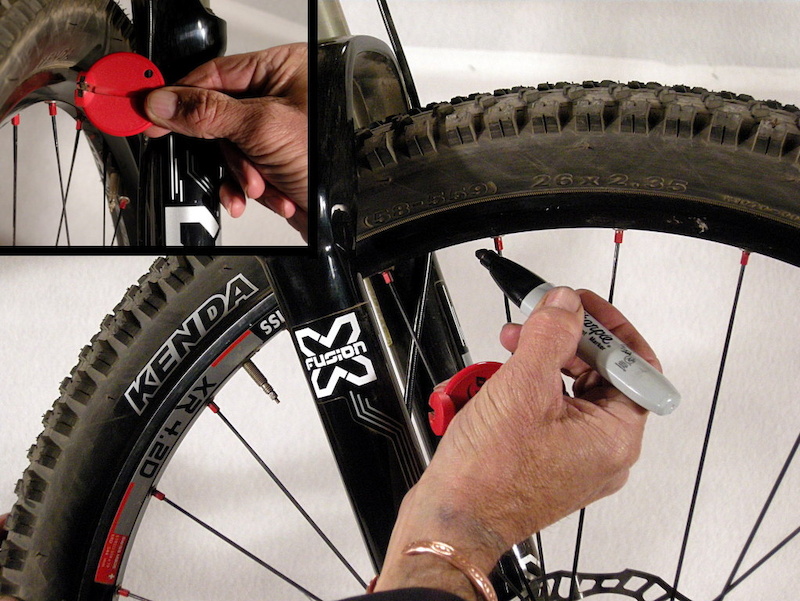
Step four: With the bike in a stand, or up-side down, brace your hand against the frame or fork and place the spoke wrench just close enough to the side of the spinning rim to hear it grind against the largest wobble in the wheel. Rock the wheel back and forth until you find the spoke nearest to the apex of the wobble. Hold that spoke or mark the side of the rim with a felt tip pen.
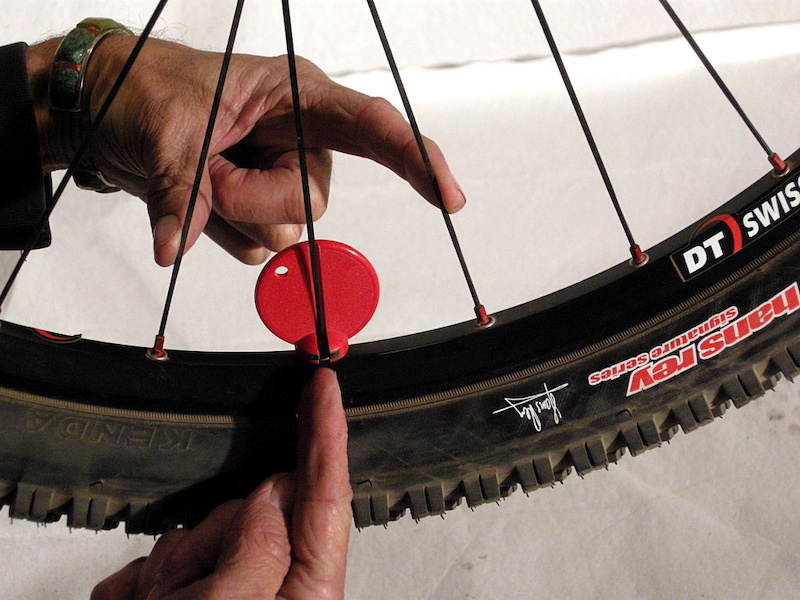
Step five: Always work out rim runout in groups of three spokes. The middle spoke at the apex of the wobble is flanked by two spokes that originate from the opposite side of the hub. First loosen the spokes (or spoke) from the hub flange that is closest to the apex of the wobble about a half turn. Next, tighten the spokes (or spoke) that originate from the opposite side of the apex the same amount. Recheck the runout and repeat until it shrinks to about a millimeter and then move on to the next wobble. Work around the wheel in sequence until you have reduced each trouble spot to about a millimeter on both sides of the rim.

Step six. Recheck spoke tension with a feel or a plink test. If the spokes are closely matched, then you are done. If there are some low-tensioned spokes left, then begin at the valve stem and tension every spoke one-fourth turn. This will bring up the tension in the entire wheel and help push the rim outwards to stretch the errant ones.

Step seven: Give the spokes a final plink test and spin the wheel to assess that the runout is within a millimeter or so. If its within 85 to 90-percent of new, you are gold.
Past Tech Tuesdays:
Author Info:
Must Read This Week
[UPDATED] Final Elite XC Results & Overall Standings from the Mairiporã XC World Cup 2024
42319 views
42319 views
Sign Up for the Pinkbike Newsletter - All the Biggest, Most Interesting Stories in your Inbox
PB Newsletter Signup
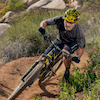
 Member since Mar 23, 2011
Member since Mar 23, 2011
poop humor never gets old!
1. when using aluminum nipples, a little drop of light oil prior to turning will save many nipples.
2. 1/4 turn backwards before tightening will save many aluminum nipples.
3. On stubborn wheels, a slight overtension, then releasing tension for final truing sometimes works. It helps prevent spoke windup.
4. Use the right spoke nipple wrench!!!! There is no such thing as "close enough" unless you want to have to buy all new nipples and start over.
5. On really stubborn wheels with seized spokes, use oil on both ends of the spoke nipple and the nipple rim interface, pluck the spokes like instrument strings, let it sit for 1/2 hour, then try to loosen then adjust the spokes. DO NOT USE WD-40 or other penetrating sprays. They will remove the little bit of lubrication held in the nipple interface.
6. For wheel assembly, I have used light weight fork oil wherever the spoke, hub, nipple, and rim touch.
7. The last step is to put the wheel on the floor and pressure/release the wheel from all different angles around the rim to release any residual spoke windup. Recheck trueness and adjust again if necessary.
A little copperslip (copper grease) on spoke threads is good for ally nipples as it has quite low "sticktion" and doesn't degrade. Helps prevent any long term bi metallic corrosion
Best text of all time on pinkbike....LOVE IT.
"only one ride away from destruction"
anyone who has built wheels will know getting it not to wobble is the easy bit, its getting the tension just right for vertical alignment that is tricky. Thats when you really appreciate a good rim to start with. (and the right size spokes (for any builders out there who have accidentally mixed up their spoke sizes in a drawer))
If you can't remove the broken spoke, bend it and hook it/zip tie/tape it to another spoke so it doesn't do any more damage as it flails around.
Blame game!
The world's gone mental !!
Shame on you pinkbike, shame on you
RC
In all seriousness I think British mild sarcasm might get culturally lost in translation. (I really don't mean that in a bad way either )
I much prefer to use the stand/my finger/that sliver of light as mentioned in another comment. And i dont mark the apex, i go from where it begins to go out of true, then hold that spoke, then spin it towards me until it goes back to the centre. Then you can do 1/4 and 1/2 turns.
1/4 turn = minor adjustment
1/2 turn = significant adjustment
1 turn = major adjustment.
I mostly use quarter turns as a small error is much easier to correct.
is it better to true a wheel with the tire on or off? Im thinking with the tire on the tire could throw the truness of the wheel off. is that right?
It's like tightening a screw from the the threaded end, you have to turn counter clockwise
If its in a stand, the nipple pointing directly at you/closest to you, is normal thread then.
RC
Lame